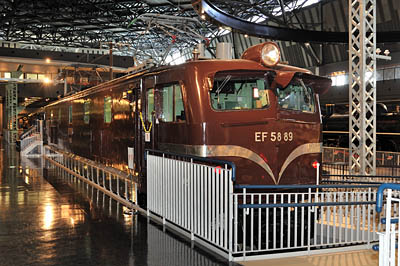
Electric Locomotive
Class EF58 |
After WW2 the first mass-produced DC passenger electric locomotive. |

|
|
Before WW2, the electrified section on the arterial line was only Tokyo to Numazu on the Tokaido line, and the distance was a mere 125 Km(78 miles). Therefore, electric locomotives produced for this section were ten in number with several small family units. During Odawara electrification on the first of February in 1926, nine of the first domestic produced model Class EF52s were manufactured until 1927. The next improved model, consisted of nineteen Class EF53s which came on the scene with Numazu electrification during 1934, and twelve Class EF56s were produced until 1940, and during WW2 fifteen Class EF57s were produced until 1943.
After WW2, when new passenger electric locomotive production was decided, there was not a great difference from the pre-WW2 designed engine's in regard to performance and appearance. This model was named EF58 and a total of thirty-one of this Prototype-EF58 were manufactured during 1946-1948. Restarted construction for Tokaido line's electrification progressed as far as Hamamatsu (total 260 km- 160 miles) during 1949 Therefore EF58s increased production was planned, but later aborted due to tight financing policy during 1949.
Two years later during 1951, these three EF58 were remodeled as a freight model and were named Class EF18 No.32-34. Accordingly EF58's numbers 32, 33 and 34 became unused numbers. EF18's still held EF58's prototype appearance after all EF58's bodies were renewed. EF58s production was restarted after tight financing policies during 1952. The restarted EF58s had a significant change in design. The new design had augmented output power and the body appearance was improved. This new appearance had a semi-streamlined look, and seemed to be a different model. During the same period, the prototype of EF58 No.1-31 were remade with new equipment, and replaced in a new body. War freight models EF13 (1944-1947) bodies were replaced with the used EF58 No.1-31's original bodies. The original EF13's bodies were discarded. When EF58s production was restarted, No35 and 36's bodies only were completed. Therefore the body's intermediate parts were diverted to the new designed body, so, EF58 No.35 and 36's window arrangement was the same as the prototype.
After the Tokaido line electrification, Japan's main line electrification program was more advanced. During Sanyo, Tohoku (Tokyo-Kuroiso), Jyoetsu and Takasaki lines electrification, EF58 saw increased production, and a total of 172 were manufactured up to 1958.
EF58 No.60 and 61 were designated Royal-Engines for VIP and Emperial use. The EF58 saw a long period of activity up to 1978, but operation decreased after that year. EF58s were retired during February of 1984 from the Tokaido and Sanyo main lines. During the next year, the EF58 was retired from the Tohoku line during March of 1985. EF58s were completely retired from regular service on the Kisei line during March of 1986. Today during 2009, there is only one working condition engine No.150 on the JR-West. EF58_150 sees service as an Event-Train once in a while. No. 61, 89, 93, 157 and 172 are preserved. No. 36, 42, 113, 144 and 154 all have cut bodys and are preserved in park museums and JR workshops.
|
|
Preserved engine EF58 No.89 (1956 - 2003)
The exhibited EF58 No.89 was manufactured at the Hitachi Co. on the 3rd of August 1956. After it's conception, EF58_89 was deployed to the Tokyo depot, but was soon transferred to Miyahara depot in Osaka. On the 19th of November 1956, when all Tokaido line electrification was completed, EF58_89 pulled a new Green-Colored first limited express up-train called "Tsubame". Afterward, she was active on the Tokaido and Sanyo lines from Tokyo or Miyahara depot. During 1963, she was temporary moved to the Takasaki depot and saw service on the Takasaki and Jyoetsu lines. During 1970, she was transferred to the Utsunomiya depot and was serviced on the Tohoku line (Ueno-Kuroiso). During 1984, EF58_89 was retired and went into the Omiya workshop due to scrapping. However, she escaped scrapping and was transferred to the Tabata depot and later she saw service as a Special Event Train. She was retired during 1997 and was crossed off her registration during 2003. Afterwards, she was preserved at the Omiya General Rolling Stock Center and later transferred and exhibited in the Railway Museum during 2007.
|
Introduction |
Go to Top |